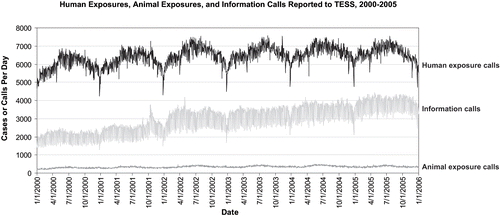Figures & data
TABLE 1A Growth of the AAPCC Toxic Exposure Surveillance System (TESS®) database
FIG. 1. Daily count of exposures in humans as reported calls made to U.S. Poison Control Centers and transmitted to the AAPCC from 2000–2005. Not all PCCs record that a call regarding an animal has occurred if the caller is immediately referred to the ASPCA hotline.

TABLE 1B Non-human exposures by animal type
TABLE 1C Distribution of information calls
TABLE 2 Site of call and site of exposure, human exposure cases
TABLE 3 Age and gender distribution of human exposure cases
TABLE 4 Distribution of age and gender for 1,261 fatalities
TABLE 21 Summary of fatal exposures reported to TESS in 2005
TABLE 5 Number of substances involved in human exposure cases
TABLE 6A Reason for human exposure cases
TABLE 6B Scenarios for therapeutic errors
TABLE 7 Distribution of reason for exposure by age
TABLE 8 Distribution of reason for exposure and age for 1,261 fatalities
TABLE 9 Distribution of route of exposure for human exposure cases and 1,261 fatalities
TABLE 10 Management site of human exposure sites
TABLE 11 Medical outcome of human exposure cases by patient age
TABLE 12 Distribution of medical outcome by reason for exposure in human exposure cases
TABLE 13 Duration of clinical effects by medical outcome
TABLE 14 Decontamination and therapeutic interventions
TABLE 15 Therapy provided in human exposure cases (frequency, divided by patient age groups)
TABLE 16 Decontamination trends
TABLE 17A Substances most frequently involved in human exposures
TABLE 17B Substances most frequently involved in pediatric exposures (children younger than 6 years)
TABLE 17C Substances most frequently involved in adult exposures (>19 years)
TABLE 18 Categories associated with largest number of reported deaths
TABLE 19 Twenty-one year comparisons of fatality data
TABLE 20 Frequency of plant exposures by plant type
TABLE 22 Summary log including demographic profile of human exposure cases reported to U.S. Poison Control Centers in 2005. Profiles are broken out by AAPCC generic categories and subcategories
